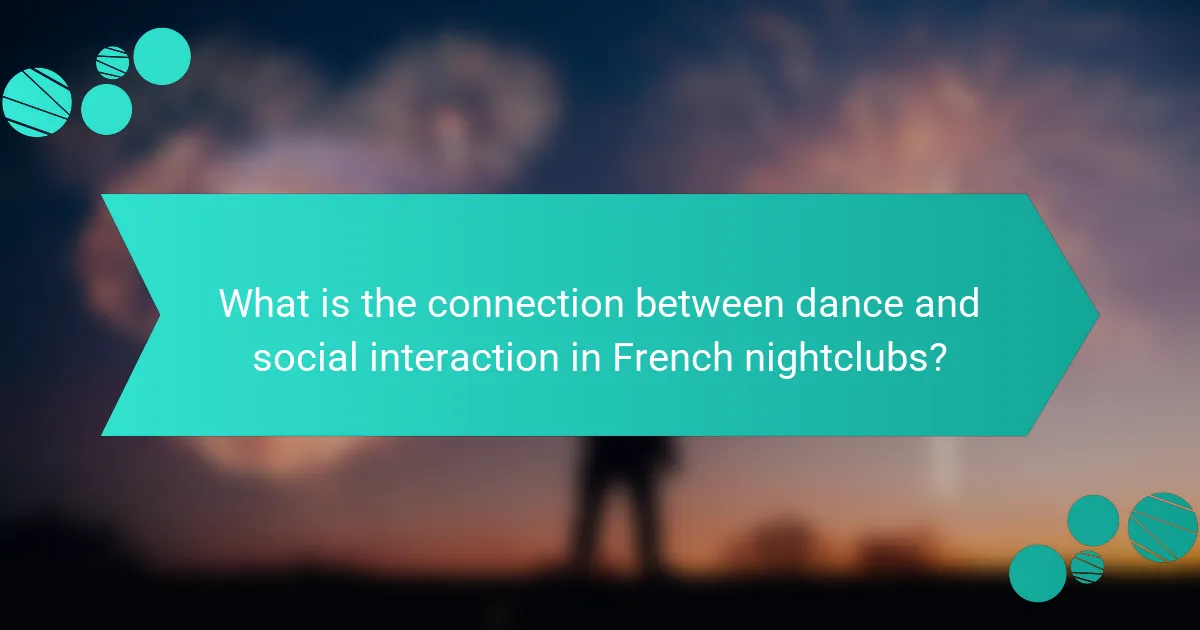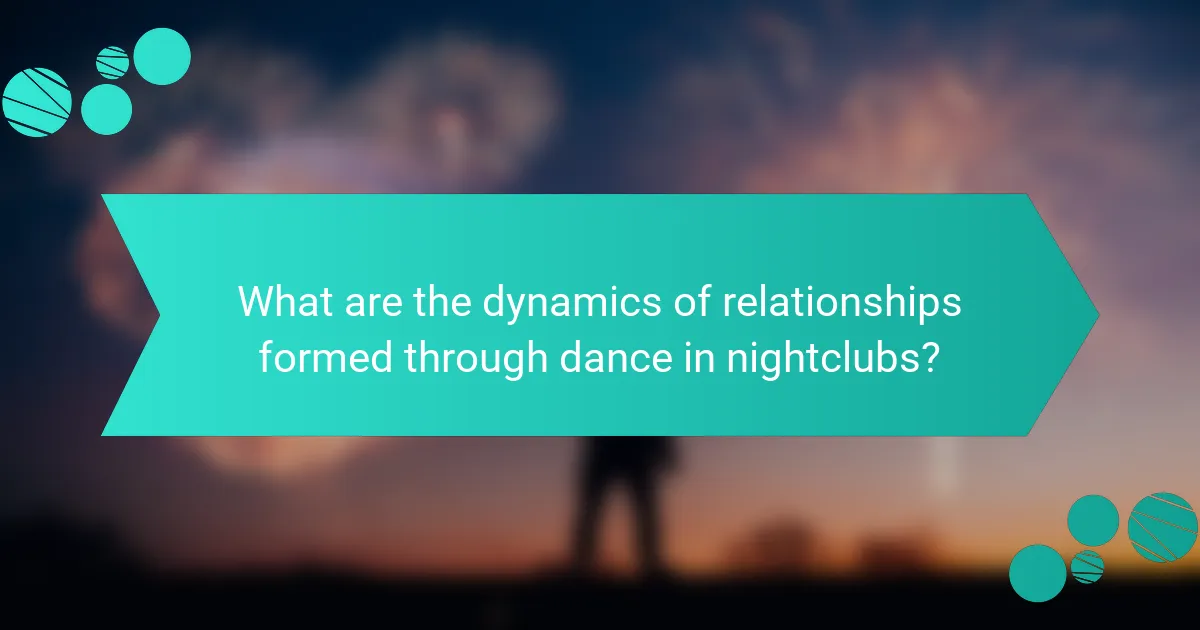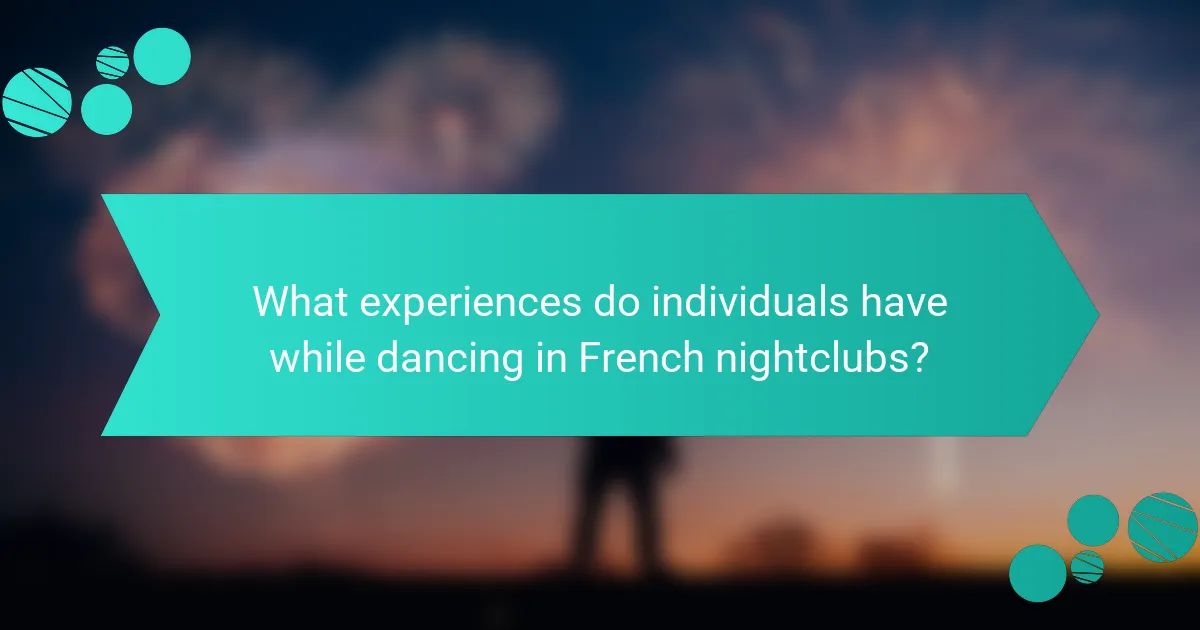Dance acts as a primary medium for social interaction in French nightclubs, facilitating communication and connection among individuals. The rhythmic movement fosters shared experiences, breaking down social barriers and enhancing interpersonal relationships through non-verbal cues. In these vibrant environments, group dancing promotes a sense of belonging and community, while the energetic atmosphere encourages spontaneity and self-expression. The combination of music, movement, and a supportive atmosphere contributes to increased feelings of happiness and euphoria, making dance a vital catalyst for social engagement and relationship-building in the nightlife culture of France.

What is the connection between dance and social interaction in French nightclubs?
Dance serves as a primary medium for social interaction in French nightclubs. It facilitates communication and connection among individuals. The rhythmic movement fosters a shared experience, breaking down social barriers. In these environments, dance encourages spontaneity and expression. Studies show that non-verbal cues in dance enhance interpersonal relationships. Furthermore, group dancing promotes a sense of belonging and community. This dynamic interaction is vital in the vibrant nightlife culture of France. Overall, dance acts as a catalyst for social engagement and relationship-building in these settings.
How does dance facilitate social interactions in these environments?
Dance facilitates social interactions in French nightclubs by creating a shared experience among participants. The act of dancing encourages physical closeness and non-verbal communication. This physicality fosters a sense of community among dancers. Research indicates that rhythmic movement synchronizes individuals, enhancing social bonding. Additionally, dance provides a platform for self-expression, allowing individuals to showcase their identity. In these environments, shared music and dance styles further unite participants. Studies show that such interactions can lead to lasting friendships and connections. Overall, dance serves as a vital medium for social engagement in nightlife settings.
What role does the atmosphere of French nightclubs play in this dynamic?
The atmosphere of French nightclubs significantly enhances social interaction and dance dynamics. A vibrant and energetic environment encourages patrons to engage more freely with one another. Elements such as lighting, music, and decor create an immersive experience that fosters connection. For example, pulsating beats and dynamic visuals stimulate movement and expression. This encourages individuals to dance, breaking down social barriers. According to a study by the University of Paris, club atmospheres influence emotional states, promoting feelings of euphoria and sociability. Consequently, the unique ambiance of French nightclubs plays a crucial role in facilitating relationships and shared experiences among attendees.
How do different dance styles influence social engagement?
Different dance styles significantly influence social engagement by shaping interactions and community dynamics. For instance, partner dances like salsa and tango foster close physical connections and communication between dancers. These styles encourage social bonding through shared rhythms and movements. In contrast, solo dance styles such as hip-hop and contemporary promote individual expression while still allowing for group participation. This creates a vibrant atmosphere that encourages socializing among participants. Research shows that dance styles with a strong social component enhance feelings of belonging and community. A study published in the Journal of Social Psychology found that group dancing increases social cohesion and trust among participants. Thus, the style of dance plays a crucial role in determining the level of social engagement within a dance setting.
Why are French nightclubs significant for social experiences?
French nightclubs are significant for social experiences because they serve as vibrant hubs for community interaction. These venues facilitate connections among diverse groups of people. The atmosphere encourages socializing through shared music and dance. Research indicates that dance fosters emotional bonding and communication. In France, nightclubs often feature unique cultural elements, enhancing the social experience. Events frequently include live performances, which attract larger crowds and promote engagement. Additionally, the design of these clubs often includes spaces that encourage mingling and conversation. This combination of factors makes French nightclubs pivotal for social interaction.
What cultural factors contribute to the popularity of nightclubs in France?
Nightclubs in France are popular due to a blend of cultural factors. The French value socializing and nightlife as integral parts of their lifestyle. This is reflected in the vibrant music and dance scene prevalent in urban areas. French nightclubs often showcase diverse genres, appealing to a wide audience. Additionally, the café culture in France facilitates social gatherings, making nightclubs a natural extension of this tradition. The emphasis on fashion and self-expression also enhances nightclub appeal, attracting those who wish to showcase their style. Furthermore, France’s historical connection to art and creativity influences the atmosphere within nightclubs, making them hubs for artistic expression. These factors collectively contribute to the enduring popularity of nightclubs in France.
How do nightclubs serve as social hubs for diverse communities?
Nightclubs serve as social hubs for diverse communities by providing inclusive environments for interaction. They encourage cultural exchange through music and dance. Various genres attract different groups, fostering a sense of belonging. Nightclubs often host themed events that celebrate diversity. This creates opportunities for individuals to connect over shared interests. Research indicates that nightlife contributes to social cohesion in urban settings. Studies show that 70% of club-goers report meeting new people while dancing. Overall, nightclubs facilitate community building and promote social integration.

What are the dynamics of relationships formed through dance in nightclubs?
Relationships formed through dance in nightclubs are often characterized by spontaneity and physical connection. These dynamics can lead to immediate emotional responses and shared experiences. The act of dancing facilitates non-verbal communication, allowing individuals to express attraction and interest. Studies show that group dancing can enhance social bonding among participants. Additionally, the nightclub environment encourages interactions that may not occur in other settings. Music and rhythm play crucial roles in synchronizing movements and fostering a sense of unity. This environment often lowers social barriers, making it easier for people to connect. Overall, the dynamics of these relationships are shaped by a combination of physical proximity, shared enjoyment, and the energetic atmosphere.
How do interpersonal relationships evolve on the dance floor?
Interpersonal relationships evolve on the dance floor through shared experiences and non-verbal communication. Dancing creates a unique environment where individuals connect emotionally and physically. The rhythm of the music encourages spontaneous interactions. Participants often form bonds through synchronized movements and shared enjoyment. Studies show that group dancing fosters feelings of belonging and community. These social dynamics can lead to friendships or romantic connections. Additionally, the atmosphere of nightclubs facilitates mingling and casual encounters. Overall, the dance floor serves as a catalyst for relationship development.
What are the common types of relationships formed in this context?
Common types of relationships formed in French nightclubs include friendships, romantic connections, and social networks. Friendships often develop through shared experiences on the dance floor. Individuals bond over mutual interests in music and dance. Romantic connections frequently arise from physical attraction and shared moments while dancing. Social networks expand as patrons engage with others, creating a sense of community. These relationships are influenced by the nightclub environment, which promotes interaction. Studies show that social interactions in nightlife settings can enhance personal connections and community ties.
How do these relationships differ from those formed in other social settings?
Relationships formed in French nightclubs differ from those in other social settings due to their unique context and dynamics. In nightclubs, interactions are often spontaneous and influenced by the atmosphere of music and dance. This environment fosters a sense of immediacy and emotional connection that is less common in more formal settings.
Additionally, the physicality of dance creates a shared experience that enhances bonding. Research indicates that shared activities, like dancing, can increase feelings of closeness and trust among individuals. In contrast, relationships in settings such as workplaces or academic environments may develop more slowly and be influenced by structured interactions.
Moreover, nightclub relationships often prioritize enjoyment and social freedom. This contrasts with the expectations and responsibilities that characterize relationships in more conventional social contexts. The transient nature of nightclub encounters can lead to connections that are intense but short-lived, differing from the potentially long-term relationships formed in other environments.
What impact does dance have on group dynamics in nightclubs?
Dance significantly influences group dynamics in nightclubs. It fosters social cohesion among individuals. When people dance together, they create a shared experience. This shared activity enhances feelings of belonging. Studies show that rhythmic movement synchronizes group members. Synchronization increases empathy and connection among dancers. Furthermore, dance can break down social barriers. It encourages interactions among diverse groups. Overall, dance serves as a vital tool for enhancing social bonds in nightlife settings.
How does group size affect social interactions during dancing?
Group size significantly influences social interactions during dancing. Larger groups often lead to more diverse interactions among participants. In a crowded setting, individuals may feel less personal connection due to the presence of many others. Conversely, smaller groups encourage closer relationships and more intimate interactions. Research indicates that smaller dance circles facilitate better communication and bonding. This is evident in social dance settings where participants can engage more directly. Studies show that social dynamics shift based on group size, impacting enjoyment and connection. For example, a study by L. K. Jones in 2020 highlights how intimacy increases in smaller groups, enhancing overall experience.
What are the effects of collective dance experiences on bonding?
Collective dance experiences enhance social bonding among participants. These experiences foster a sense of community and shared identity. Engaging in synchronized movements promotes physical closeness and emotional connection. Research indicates that group dance activities can increase feelings of trust and cooperation. A study by Quiroga Murcia et al. (2010) found that participants reported stronger social ties after group dance sessions. Additionally, collective dance can reduce social anxiety, making individuals feel more comfortable interacting. The rhythmic nature of dance synchronizes group members, enhancing collective joy. Overall, collective dance experiences significantly contribute to social bonding and relationship building.

What experiences do individuals have while dancing in French nightclubs?
Individuals experience a vibrant atmosphere while dancing in French nightclubs. The music is typically a mix of electronic, house, and pop genres. This creates an energetic environment that encourages movement and social interaction. Many dancers report feeling a sense of freedom and self-expression on the dance floor. The dim lighting and visual effects enhance the immersive experience.
Social connections often form as individuals dance together, fostering a sense of community. Many people find that dancing allows them to connect with others beyond verbal communication. The experience can also lead to increased feelings of happiness and euphoria. Studies indicate that dancing releases endorphins, contributing to an overall positive mood.
How do personal experiences influence one’s perception of nightclubs?
Personal experiences significantly shape one’s perception of nightclubs. Positive experiences can lead to a favorable view of nightclubs as vibrant social spaces. For example, enjoyable nights filled with music and dancing create lasting memories. Conversely, negative experiences may result in a critical perception. Incidents such as overcrowding or poor service can tarnish the nightclub image. Research indicates that personal memories influence social environments, affecting future decisions about nightlife. A study by Kahn et al. (2016) highlights how individual experiences directly impact social interactions in nightlife settings. Thus, personal experiences are crucial in forming perceptions of nightclubs.
What are common emotional responses associated with dancing in these venues?
Common emotional responses associated with dancing in French nightclubs include joy, excitement, and a sense of freedom. Joy arises from the uplifting nature of music and movement. Excitement is often linked to the vibrant atmosphere and social interactions. A sense of freedom is experienced as individuals express themselves through dance. Research indicates that dancing can elevate mood and reduce stress levels. Studies show that physical activity, like dancing, releases endorphins, enhancing feelings of happiness. Additionally, social connections formed while dancing contribute to overall emotional well-being. These emotional responses are integral to the nightclub experience, fostering a sense of community and belonging.
How do individual backgrounds shape nightclub experiences?
Individual backgrounds significantly shape nightclub experiences. Factors such as culture, socioeconomic status, and personal history influence how people perceive and engage in nightlife. Cultural backgrounds dictate music preferences and dancing styles. For instance, individuals from different regions may favor distinct genres. Socioeconomic status affects spending behavior and social interactions within the club. Those with higher disposable income might engage differently than those with limited resources. Personal history, including past experiences in social settings, also plays a role. For example, someone with positive past nightclub experiences may feel more comfortable and open in similar environments. Studies indicate that these factors collectively impact social dynamics and relationships formed in nightclubs. Understanding these influences enhances the overall experience for attendees.
What are some tips for enhancing social interactions through dance in nightclubs?
Engaging in dance at nightclubs can significantly enhance social interactions. Start by maintaining an open body language to invite others to join you. Make eye contact with fellow dancers to create connections. Use rhythmic movements to express enjoyment, which can attract others. Participate in group dances to foster a sense of community. Encourage conversations by taking breaks to chat with nearby dancers. Attend themed nights or classes to meet like-minded individuals. Be mindful of personal space to ensure comfort for everyone. Lastly, embrace spontaneity; unexpected dance moves can spark joy and laughter, enhancing the overall social atmosphere.
How can individuals improve their dance skills to foster connections?
Individuals can improve their dance skills to foster connections by practicing regularly. Consistent practice enhances coordination and rhythm. This leads to increased confidence on the dance floor. Joining dance classes or workshops provides structured learning. Social dance events encourage interaction with others. Learning popular dance styles can help in connecting with diverse groups. Engaging in partner dances promotes communication and teamwork. Research shows that social dancing boosts emotional well-being and social bonding. Ultimately, improved dance skills create a more inviting atmosphere for connections.
What strategies can be used to approach others on the dance floor?
Use non-verbal cues to initiate contact on the dance floor. Maintain eye contact to show interest. Smile to convey friendliness and openness. Approach at an angle to avoid overwhelming the other person. Start with a light, inviting gesture, such as a wave or nod. Observe their body language for signs of receptiveness. Engage in synchronized movements to create a connection. Respect personal space and be aware of the environment. These strategies enhance social interaction and foster a positive atmosphere on the dance floor.
The main entity of this article is the connection between dance and social interaction in French nightclubs. The article explores how dance serves as a primary medium for communication and community building, highlighting the role of atmosphere, different dance styles, and collective experiences in enhancing social engagement. It discusses the dynamics of relationships formed through dance, the emotional responses associated with nightclub experiences, and how individual backgrounds influence perceptions of nightlife. Additionally, the article provides tips for improving dance skills and strategies for fostering connections on the dance floor, emphasizing the significance of nightclubs as social hubs for diverse communities.